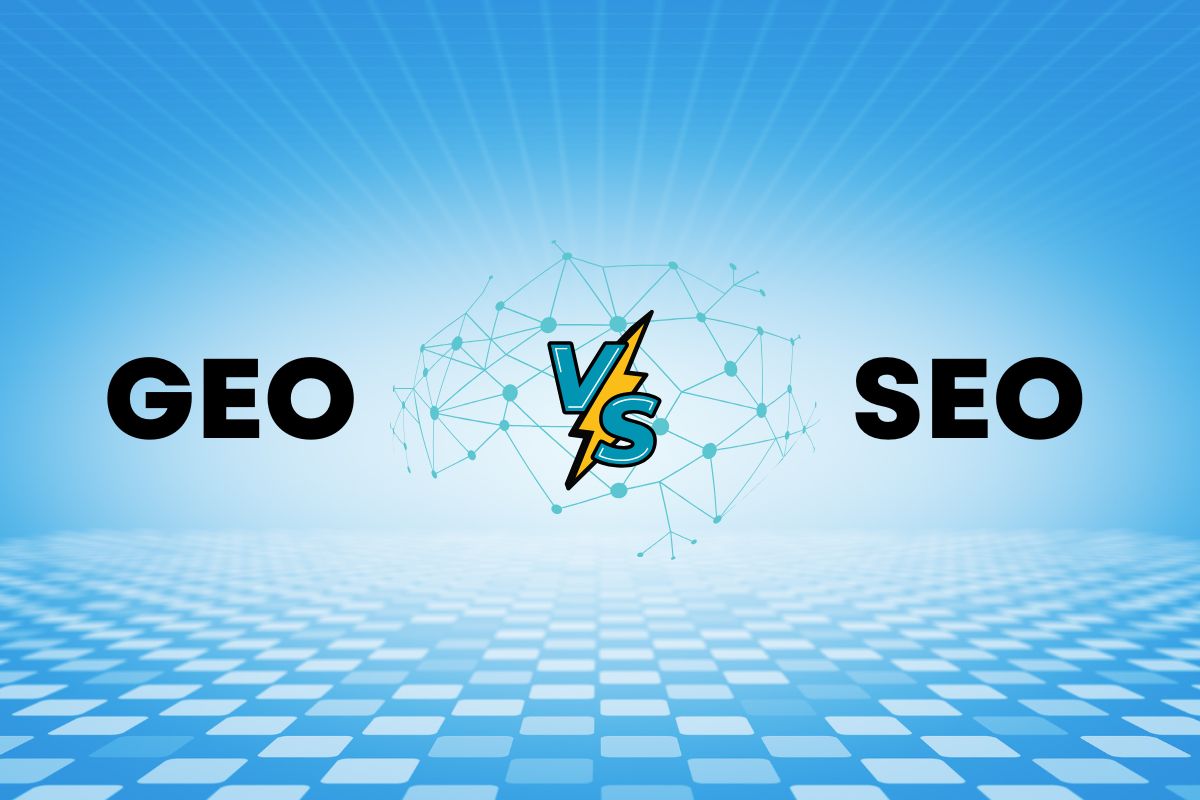If you’re running a business today, the odds are good that you have heard people talk about “SEO” and “Geo”. But which one do you really need to pay attention to? Would you rather target the whole world or just those people who are nearby? This guide will tell you both what the difference is and why it matters to get this right — especially in 2025.
What is SEO?
SEO stands for Search Engine Optimization. It’s about making your website show up higher on Google when people search for what you sell.
For example, if you own a bakery in Houston and someone searches “best chocolate cake,” you want your site to appear near the top.
Good SEO covers many things. It includes writing helpful content, making sure your site is fast, getting other trusted websites to link to you, and even how your pages are set up. According to Moz, these signals help Google figure out which sites best answer a search.
SEO is valuable because it brings in free (or “organic”) traffic. You don’t pay Google for clicks. Instead, you earn your spot in search results.
What is GEO?
GEO is short for Generative Engine Optimization. It’s really just about helping your website show up when people use those new chat-based search tools.
These days, people aren’t only using Google in the old way. They’re asking things in tools like ChatGPT or other AI helpers that give them written answers instead of just a list of links.
If you want your business to get mentioned in those answers, you need to make sure your website is clear, helpful, and easy for these tools to understand. That’s what GEO is all about.
It’s a way to make sure people can still find you, even if they’re using new ways to search. In the end, it helps bring the right visitors to your site and keeps them interested in what you offer.
Geo vs SEO: The Key Differences
Both Geo and SEO are about getting people to find you online, but they are done in very different ways.
SEO is something that most of us have already heard about. It makes your website appear in traditional search engines, such as Google and Bing. It has to do with using the proper words on your pages, writing useful posts, linking correctly, and ensuring your website is structured in a way that communicates its value so that Google wants to show it to people.
Geo is a bit newer. It’s how to be visible in those chat-style search tools that give people the answers to their questions, not links. ChatGPT or Google’s new AI writes out responses to questions. If your site explains concepts well, these types of tools may use some of your language — or at least reference your business — in their responses.
Although they are different, they have the same purpose: to get you in front of people who are seeking what you sell.
Let’s say you own a bakery in Austin.
- SEO helps you show up when someone searches on Google for “best cupcakes in Austin.” You want to be on that first page so they choose you over other shops.
- Geo helps you appear when someone asks an AI tool, “Where can I get good cupcakes near me?” If your website has clear, helpful details about your menu, location, and quality, the AI tool might include you in its answer.
Or imagine you’re a plumber in Chicago.
- SEO helps you rank when someone types “emergency plumber Chicago” into Google.
- Geo helps you get mentioned when someone uses an AI assistant and says, “I need a plumber nearby.”
Both also need you to think about the words you use. You want to include terms people actually search for. You also need to make sure your website is easy to use on phones, loads quickly, and has good information people can trust.
If you’re running a business today, you probably need both. SEO makes sure you’re in traditional searches. Geo helps you show up in these new ways people are searching. Using both means you won’t miss anyone who’s looking for you, no matter how they search.
Can You Use Both Together?
You don’t have to pick between geo and SEO. In fact, using both at the same time is often the best plan.
Think of SEO as the basics. It’s what gets your website showing up in regular Google searches. It makes sure your site runs well, loads quickly, works on mobile, and has good, clear information that answers people’s questions.
Geo builds on that. It helps you get noticed in those new tools that talk back to users and give written answers. But you can’t really do geo well if your regular SEO isn’t solid first.
For example, say you run a local pizza shop. Your SEO work might make sure you appear when someone searches “best pizza in town” on Google. At the same time, your geo strategy means your site has the kind of clear, useful details that a chat assistant or AI result might pull in when someone says, “Where can I get pizza nearby?”
The idea is to write in a way that works for both. Be clear. Be helpful. Use words people actually use. Share honest details about what you offer and where you’re located. Make sure your website loads fast and works on phones, because that matters everywhere.
You don’t want to miss out on any customers. Some will still use the old way of searching on Google. Others will be asking about those new chat tools. By doing both, you make sure you’re easy to find no matter how people look.
In the end, it’s about being there for your customers wherever they are—on any search, any device, any platform. That way, you’re not leaving money on the table and you’re making sure people can choose you when they’re ready to buy.
Why It Matters for Small Businesses
Small businesses need every bit of visibility they can get, especially when money is tight. GEO is important because it helps your website get found in the new kinds of search results that people are using more and more.
It’s not just about showing up in old-style Google links anymore. People are asking those chat-based tools questions and getting written answers back. If your site has clear, helpful information, those tools can mention you in their answers.
For a small business, that means you have another way to get noticed without spending a lot on ads. It can bring in people who are looking for exactly what you offer.
Think about someone asking an AI helper, “Where can I buy fresh flowers near me?” or “Who’s a good accountant in my area?” If your website is easy for these tools to read and share, you’re more likely to be included in those answers.
It’s an extra path for customers to find you, which is valuable when you don’t have big marketing budgets. GEO makes sure you’re not left out as the way people search keeps changing.
Is GEO Replacing SEO?
GEO isn’t here to replace SEO. It’s really meant to work alongside it.
SEO is still the foundation for getting your website to show up in regular search results on Google and Bing. It helps make sure your site is easy to find when people look for what you offer.
GEO is a newer layer on top of that. It helps your content get noticed in the answers that come from AI-powered tools. These tools don’t just list links—they try to give people full answers right there on the screen.
If your site is clear, useful, and well-written, it’s more likely to be included in those new types of answers. That way, even as people change how they search, they can still find you.
In 2025, businesses really need both. SEO helps you keep your spot in classic searches. GEO makes sure you stay visible in these new chat-based results. Together, they help you reach as many customers as possible, no matter how they choose to look for you.
Is SEO Dead Without GEO in 2025?
No, SEO isn’t dead at all—but skipping GEO can put you behind.
As search keeps changing, people are using more AI-powered tools that answer questions directly. Google’s own AI Overviews are already giving users full summaries right on the search page. If your content doesn’t work well for those systems, you might miss out on being mentioned at all.
Microsoft is also pushing Copilot in Bing to deliver rich answers, pulling from many sources. This shift means people often don’t even click through to websites anymore unless they see you in that written response.
If you only do traditional SEO and ignore how these tools choose what to share, you risk losing visibility as more searches move to these new formats. GEO helps you adapt by making sure your content is clear, helpful, and structured in ways these AI tools can easily use.
In 2025, businesses that want to stay easy to find need to think about both. SEO keeps you in the regular results. GEO gets you included in these new AI-generated answers that more people rely on every day.
Real-Life Use Cases: How Businesses Improved with GEO
Businesses are seeing that doing both classic SEO and GEO helps them get noticed in new ways people search.
For example, health clinics that added clear, helpful FAQs to their websites are now showing up in Google’s new AI Overviews. When someone asks, “Do I need a referral?” the AI summary might use their answers, bringing them new patients.
Online stores are writing better product descriptions and answering common customer questions right on their pages. Shopify even recommends this approach because it helps sites appear in both normal search results and AI-powered answers.
By making their sites easy for AI helpers to read and share, these businesses are reaching more people without paying for extra ads. GEO is helping them stay visible even as the way people search keeps changing.
How Google Treats GEO in Search Results
Google has changed a lot with how it shows answers. Now, it doesn’t just list links. It also gives full written summaries at the top of the page. These are called AI Overviews. When someone asks a question, Google’s AI pulls bits of information from different websites to write an answer right there on the results page. If your site has clear, helpful content, it’s more likely to be used in these summaries.
This is what GEO focuses on. It means making sure your content is easy for Google’s AI to read and share in those overviews. Businesses that do this well can get mentioned in these answers, making them more visible to people even if they don’t click on links.
In 2025, showing up in these AI-written results is becoming just as important as ranking in traditional search lists. GEO helps you stay part of that change so customers can still find you no matter how they search.
Beginner Mistakes in GEO (And How to Avoid Them)
One big mistake is writing content that’s too vague or confusing. AI tools pick answers that are clear and direct. If your site has messy or unclear writing, it’s less likely to get used.
Another problem is ignoring the questions people actually ask. If your website doesn’t answer real customer questions in simple language, those AI helpers won’t pick you when giving answers.
Some businesses also stuff in too many fancy words or overcomplicate things. AI systems prefer natural, easy-to-understand writing.
And don’t forget to keep your content updated. Out-of-date info can get skipped over. Make sure you regularly check that your details, prices, and services are current.
By avoiding these mistakes, you make it easier for AI-powered search results to choose your content when helping users find answers. That means more people see your business, even as search keeps changing.
Tools I Use to Balance SEO & GEO
Balancing SEO and GEO means making sure your website is easy to find in all the ways people search for answers. Here are some simple tools that help with both:
- Google Search Console is really helpful. It shows you how people find your website on Google. You can see which pages get the most visits and what questions bring people in. This helps you improve your writing so it’s clearer and more useful.
- Ahrefs and Semrush help you find the right words and topics. They show you what people are actually searching for and where you can do better. This is good for making sure your content matches what real customers want to know.
- Your website platform (like WordPress or Shopify) matters too. You need something that makes it easy to update your pages, so your information stays fresh and accurate.
- Analytics tools (like Google Analytics) let you see what parts of your website people read most. This helps you figure out where you might need simpler, clearer answers.
Using these tools helps you make your website stronger for traditional search and for newer search formats. It means you’re making sure people can find you and get the information they need, no matter how they choose to look.
Conclusion
It’s not a matter of either/or in 2025, GEO or SEO. It’s using both to help people find you wherever they search.
SEO is still the base. It’s what gets your site to appear in regular Google search results, and it attracts visitors over time. GEO is the new piece that helps you show up in those chat-style answers and AI summaries that we’re all coming to depend on more every day.
When you do both, you help ensure that your content is clear, helpful and easy to find no matter how someone is searching. You do not miss out on customers, whether they click links or read AI-generated answers.
If you want to grow your business in 2025, don’t ignore them. Build your site strong for the traditional search and prepare for how people are going to search in the future. That way, you’ll remain visible, useful, and ahead of the curve.











